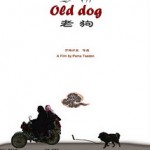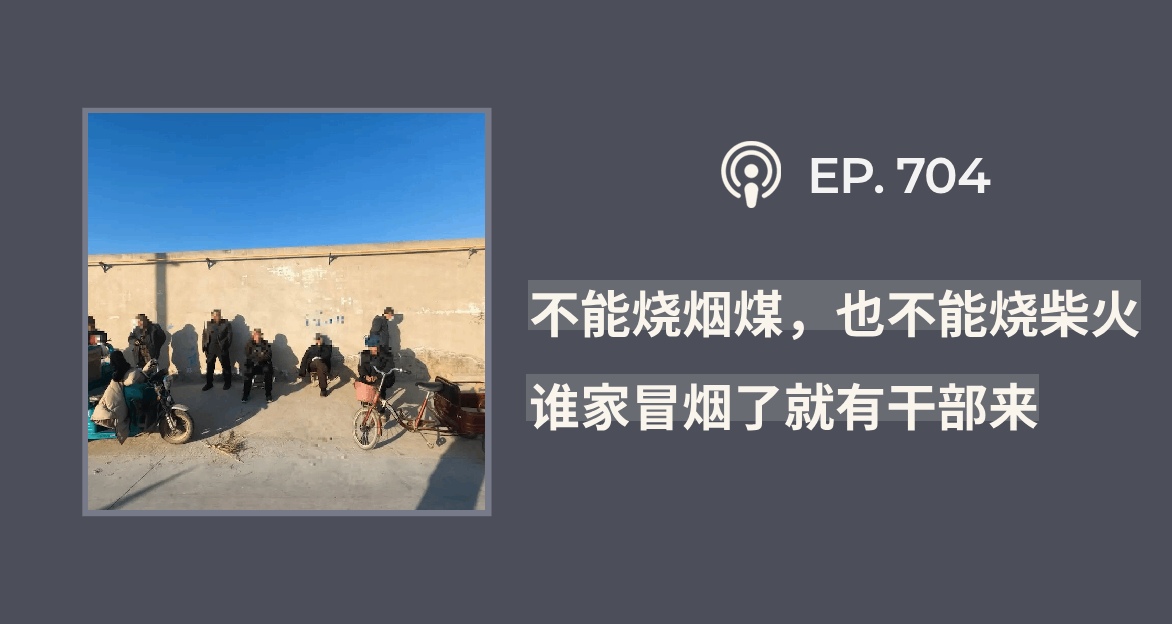《老狗》和《太阳总在左边》之影评
文/茨仁夏加(Tsering Shakya)
译/黄潇潇
《老狗》(Khyi rgan),导演:万玛才旦
《太阳总在左边》(Dbus lam gyi nyi ma),导演:松太加
万玛才旦的《老狗》开场,一位英俊的藏人青年骑摩托车进城,带着一条拴在铁链上的狗。这只狗上了年纪,毛发蓬松。青年身材刚健,在屏幕上显得特别突出,但后来我们从电影中发现,他没有生育能力(让人想起陈冲在《天浴》中刻画的一位文革时期的藏人)。《老狗》讲述的是在进步和发展的幌子下,对身体和空间的阉割。这部电影探讨中国的经济转型(而不是文化大革命)对西藏(或任何其他民族)文化的侵蚀及其产生的不稳定影响。电影从当代历史中取材,故事背景是中国新富突然对西藏牧民养的藏獒表现出的狂热兴趣。就在不久前,一只名叫“轰动”的藏獒在中国以一千万元成交。
这种狗给牧民看守帐篷和牲畜,它们在中国已成为心所向往的对象、庸俗的炫富手段。藏獒热刺激了社会力量与边缘牧民群体的首次接触;这利润可观的贩狗生意,以及偷盗和诱拐,已经迫使藏人家庭作出抉择,要么在自己的狗被偷走以前把它卖掉,要么把狗留着,尽管知道它迟早还是可能被偷走。
在电影的开头,由业余演员洛杰饰演的贡布去附近的乡里,打算把自己的狗卖给一个当地汉商。他的摩托车在泥泞的街道上轧轧响着前行。各种迹象显示,这是个正在建设中的边陲乡镇:土路上覆盖着厚厚的泥巴,造了一半的房屋排列在这几乎空无一人的道路两旁。这些场景是从远处拍摄的,给予那里的生活以一种平凡感。万玛才旦并不将焦点聚集在镇里某一具体方面,也不用特写或细节镜头,那样的镜头可能会使我们感受到这个镇的特点而获得某种慰藉。电影不以特定主体为焦点,也不容许亲密感,使观者丧失参与的错觉,把他们限制在一段距离以外来观察:我们是真正的旁观者。我们从远处观察到的是荒凉的景象、单调的日常生活,以及一个家庭每日挣扎着面对全球化和都市中心带来的压力。
贡布把狗卖了,但我们得知他这样做没有得到父亲的同意,他为自己辩护的理由是:“与其让狗被偷,不如换点钱。”父亲发现这事后,亲自去镇上找狗。他养这只狗已经12年,与狗的分离使他痛苦万分。这位父亲引述西藏的传统,该传统禁止将狗作为商品或坐视狗被买卖。“你长得不像你爸,你的样子一点也不像他,”他对狗贩子说。这位狗贩子的父亲曾是猎人,因为养了12只藏獒而闻名。
在电影《老狗》中,这只家养的藏獒成为家庭和社群之间紧张与冲突的来源;在处理这只动物时,人与人的关系开始瓦解。万玛才旦的脑海中可能想到了藏语词“Chag go”,意思是灾难、不幸、冲突等,因为这些似乎才是那只受人喜爱的家养藏獒所带来的,多少有些矛盾;倒不是因为狗着了魔或者不听话,而是因为他人的贪婪和欲望。父子之间的关系受到了干扰,现在必须时刻盯着藏獒,以免它被偷走。狗贩子不断出高价来骚扰这个家庭,而贡布在跟狗贩子打架之后也把自己送进了派出所。贡布曾决心把狗卖给这个狗贩子。
电影《老狗》从藏人的视角看今日藏地图景,其中贫穷牧民在国家支持的经济发展及其对当地家庭造成的边缘化影响之下面对日常生活。电影里没有发光的天空或连绵起伏的高山草原,而是通过严酷和受损的风景,来表现西藏高原上当代牧民的生存现实。在那种斯巴达式的家园中,我们看到用铁丝网圈起来的土地,这里暗示最近出台的一项有争议的政策,旨在结束牧场公地的使用:电影中的围栏比喻监禁,以及国家对当地生活的侵入。在一场戏里,一只绵羊夹在围栏中,挣扎着要加入草地另一边的羊群,只有那些不了解围栏政治的人才会把这看成是喜剧穿插。《老狗》中遍布着充分体现入侵的主旨:栅栏既象征私有化经济,又象征对土地和民众的剥夺;试图说服老人卖狗的贩子,他说狗到了城里的生活会更好(老人回应:“那城里人又在害怕什么?”);及因为贪婪和商业机会主义而遭窃的穷人的宝贵财产。
电影戏剧性的结局让观众沉浸在思考而不是情感中,导演并不试图用特写或单个图像来刺激情绪。相反,观众的凝视被老人的脚步所吸引,他就那样走开,不回头检视自己行为的结果。这镜头又延续了几分钟,只听到老人的呼吸声,看不到老人的脸,我们的注视因此无法聚焦在他身上,而只能集中在自己的思绪里。
万玛才旦在这部电影中使用业余演员,正如在他多数作品中那样,这就给予电影一种自然的感觉,避免了做作的情感。《老狗》中的父亲在镇上走动,与他的家人互动,几乎就像实时进行中一样,使得尽管他象征着“好人”的精髓,片中却没有延续民族电影中常见的那种“高贵的野蛮人”的刻画。相反,我们看到电影以具有尊严的方式描绘着一位正派的人处理侵入所带来的复杂影响。《老狗》是对藏地生活的有力描绘,但这部电影同时也是关于穷人和边缘人在全球化背景下经历的普遍挣扎。它也关涉今日中国那些弱势的、住在经济繁荣圈边缘的人们,不管他们来自哪个民族。这是一个证据描述,是对当前状态的叙事记录,其中没有教训癖也不挑起争论,因此它将被视为对当代西藏现实的最好描述之一。
松太加是《老狗》的摄影师,他曾与万玛才旦在多部电影中合作,使得他们两人成为第一代藏族独立电影人中的领军人物。现在松太加已经从摄影机旁退到导演席上,完成了他的导演处女作《太阳总在左边》,这部电影已在今年获得大奖——温哥华电影节授予新锐导演的龙虎奖。《太阳总在左边》被描述为公路电影以及自我发现的旅程,跟《老狗》一样,这部电影也起用了业余演员,并且在位于西藏高原东北部的导演家乡拍摄。
在电影的开头,年轻的主角尼玛将一辆摩托车推下悬崖。影片通过一系列闪回的前后穿插讲述发生的事,让我们得知尼玛正在进行一段充满罪恶感的旅程。我们发现那辆摩托车就是这罪恶感的根源:尼玛开着一台拖拉机载母亲回村时,因为这辆摩托车,母亲在意外中丧生。尼玛对这场意外深感自责,他六神无主,无比困惑,身边的世界分崩离析。电影开场时,他已经结束了一场强加给自己的赎罪之旅,过程极度痛苦。他从家乡开始三步一个长头,直磕到一千多英里外的西藏首府拉萨。
电影展现出他从拉萨返回时的最后几天旅程,他一路搭卡车和汽车,更多的时候只是步行,就这样再次靠近自己的家。影片里,他几乎一言不发,但我们从他脸上因日晒而变化的肤色中,看出他的迷惑和艰苦。我们能感觉到,尼玛不确定自己是否在道德上有资格回家,他甚至一度离开他刚刚坐上的汽车,只因为汽车开得太快。在路上,一位老者与他结识,老者感觉到这年青人正在苦恼中,但以为他是和妻子或者女朋友闹矛盾。尼玛最初拒绝老者的陪伴,但老者知道路上的艰难,也知道一个没有经验的旅行者可能会在阳光和土地的严酷中面临死亡,所以他并不灰心,反复劝说尼玛,希望尼玛明白,他的过犯已经得到足够的抵消。
这部电影既是“善良的陌生人”的故事,又是发现的故事。正如在《老狗》中那样,老者代表善良、过去的力量,以及用积累智慧来作为解决当前现实的手段。在《太阳总在左边》中,多数对话都是老者在向尼玛讲述自己的生活经历,以此来劝告和安慰尼玛。男孩看上去没有在听,但我们最终发现,老人将尼玛带上了和解之途。
《太阳总在左边》讲述了一个简单而又不失深度的故事,因其采用业余演员,使全片拥有一种自然的风格。两部影片都不依靠对话叙事,而靠风景和远景,在屏幕上突出演员的同时,也将观众置于旁观者而非参与者的角色。整出戏在我们面前展开,却没有一个特别的视觉焦点,创造出万玛才旦曾描绘的那种卷轴画或壁画美学的电影版:这些画面呈现出完整的故事,而不是一场戏或一个主体。
在电影《老狗》和《太阳总在左边》里,雄伟的雪山或连绵的高山草原产生的浪漫画面,被冷酷无情的风景所取代,人们在其中挣扎生存,乡镇在其中显得突兀而不协调。这样的风景,就为西藏高原上正在发生的改变之现状提供了背景。两部电影讲述日常生存的故事,这些故事既是藏族特有的,又触及有关挣扎和赎罪的普遍主题,同时回避了矫揉的情感和浪漫主义的叙事手法。
【作者:茨仁夏加,英属哥伦比亚大学亚洲研究所西藏历史学教授,历史学家,作家。
译者:黄潇潇,《一位藏族革命家: 巴塘人平措汪杰的时代和政治生涯》一书译者。本篇译文在我博客上为首发。】
Old Dog (Khyi rgan) directed by Pema Tsetan & The Sun-Beaten Path (Dbus Lam Gyi Nyi Ma) directed by Sonthar Gyal
by Tsering Shakya
Pema Tseden’s “Old Dog” (Khyi rgan) opens with a handsome Tibetan youth riding into a town on his motorbike with an aged, shaggy dog tied to a chain. The youth looks virile and has a strong bodily presence on the screen, but we learn later in the film that he is impotent [reminiscent of Joan Chen’s depiction of a Tibetan man during the Cultural Revolution in “Xiuxiu – The Sent Down Girl”]. “Old Dog” is about the emasculation of body and space in the guise of progress and development. The film deals with the encroachment and destabilizing effect on Tibetan – or perhaps any – culture [not of the Cultural Revolution but] of China’s economic transformation. The film draws from contemporary history by situating the story in the sudden emergence of a feverish appetite among China’s nouveau riche for the mastiffs owned by Tibetan nomads, such that recently a mastiff named Hong Dong sold in China for $1.5 million.
These dogs, used by the nomads to guard their tents and animals, have become an object of desire and a vulgar display of wealth in China. The craze for them has spurred social forces into interaction with remote nomad communities for the first time, through a lucrative trade in the dogs, as well as theft and kidnapping of them, that has forced Tibetan families into choosing between selling their dog before it is stolen or keeping the dog knowing that is most likely to be dognapped sooner or later.
At the start of the film Gonbo, played by amateur actor Loche, is visiting the nearby town to sell his dog to a local Chinese dealer. As the motorbike chugs along the muddy street, there are signs that this is a frontier town under construction, with dirt-track streets deep in mud and half-built houses along both sides of the almost deserted road. The scenes are shot from a distance, giving a sense of the mundaneity of life there. Pema Tseden does not focus on one particular aspect of the town, allowing no close ups or detail shots that might gives us the consolation of getting a sense of its character. No particular subject of focus is allowed or intimacy permitted, depriving the viewer from the illusion of participation, limiting him or her to observing from a distance: we are truly spectators. What we observe from afar is a bleak landscape, the monotony of everyday life and the daily struggle of a family grappling with globalization and pressure from the metropolitan centre.
Gonbo sells the dog, but we learn that he has done it without his father’s approval, because, he argues, “it is better to get some money before the dog gets stolen.” But once the father discovers this, he goes to the town himself to recover the dog, which he has raised for 12 years and is deeply pained to be parted from. The father draws on Tibetan tradition, according to which it is taboo to use dogs as a commodity or to allow them to be bought and sold. “You don’t look like your father – your face doesn’t even resemble his”, he tells the dealer, whose father had been a hunter famous for having raised twelve mastiffs.
In “Old Dog”, the family dog becomes a source of tension and conflict within the family and community; society starts to break down in its dealings over the animal. Pema Tseden might have had in mind the Tibetan word chag go, which stands for disaster, misfortune, conflict, and so on, because it is these that, paradoxically, the beloved family dog seems to be the source of, not because the dog is possessed or bad but because of the avarice and desire of others. The relationship between father and son is disturbed, the dog has to be guarded at all times from dognappers, dealers constantly harass the family with increasing offers, and Gonbo lands himself in jail after fighting with a dog dealer to whom he is determined to sell the dog.
“Old Dog” is a Tibetan’s view of the Tibetan landscape today, in which poor nomads confront everyday life under the march of state-sponsored economic progress and its marginalisation effect on local families. It presents the contemporary reality of nomads on the Tibetan plateau not through images of luminescent skies or rolling alpine meadows, but a harsh and damaged landscape. From the spartan homestead we see barbed-wired fenced fields, a reference to a controversial policy recently introduced to end the use of common land on the grasslands: the fence becomes a metaphor in the film for confinement and for state encroachment on local lives. In one scene, a sheep is stranded between fences as it struggles to join the flock on the far side of the field, but it serves as comic relief only for those who don’t know the politics of fencing. “Old Dog” is littered with motifs that speak volumes of intrusion: the fence that signifies both the economics of privatization and deprivation of the land and the people, the dealer who tries to persuade the old man to sell his dog by saying that the dog will have a better life in the city (the old man responds, “So what is it that the city folks are frightened of?”), and the treasured possession of the poor that is stolen because of greed and commercial opportunism.
The dramatic ending leaves one overwhelmed with thought rather than emotion, without the director inducing sentiment through the use of close ups or single images. Instead, the audience’s gaze is directed to the footsteps of the old man as he walks away, without looking back to see the results of his action. The shot continues for several minutes, with only the sound of the old man’s breath. Our gaze is turned not to the old man, whose face we do not see, but to our own minds.
Pema Tseden uses amateur actors in this film as in most of his work, giving a naturalistic sense but avoiding sentimentality. The father in “Old Dog” is shown going about the town and interacting with his family almost as in real time, so that, even though he represents the essence of “the good man”, there is no perpetuation of the “noble savage” image so often found in ethnic drama. Instead, we see a dignified portray of a decent man dealing with the complex impact of intrusion.
“Old Dog” is a powerful portrayal of life in Tibet, but is also about the universal struggle experienced by the poor and the marginalized in the face of globalization. It is also a film about those who are disadvantaged and live at the margins of the economic boom in China today, whatever their ethnicity. It is an evidentiary account, a narrative record of the contemporary condition, which is shorn of didacticism or polemic, and as such it will be regarded as one of the best depictions of the contemporary reality of Tibet.
Sonthar Gyal is the cinematographer for “Old Dog” and worked with Pema Tseden on his previous films, making them two of the leading figures in the first generation of independent Tibetan filmmakers. Now Sonthar Gyal has stepped back from the camera to make his directorial debut with “The Sun-Beaten Path” (Dbus lam gyi nyi ma), which has already won a major award this year – the Dragons & Tigers Award for a first time director at the Vancouver Film Festival. “The Sun-Beaten Path” is described as a road movie and a journey of self-discovery, which, like “Old Dog”, also uses amateur actors and location-shots in the director’s home area in the north-east of the Tibetan plateau.
The film begins with Nyima, the young protagonist, pushing a motorbike off a cliff. The film tracks back and forth through a sequence of flashbacks to tell the story of what has happened, allowing us to see that Nyima is on a journey and is consumed with guilt. We discover that the motor-bike is at the source of this: while driving his mother back to the village on a farm tractor, she has been killed in an accident involving the bike. Nyima, blaming himself for the accident, is distraught and confused, his world in ruins around him, and by the time the film opens he has already completed an agonizing and self-imposed journey of expiation from his home to the Tibetan capital, Lhasa – a thousand miles or more – in which he has prostrated himself every three steps along the way.
The film shows the final days of his return journey from Lhasa, hitching rides in trucks and buses or more often walking, as he nears his family home again. He hardly utters a word in the film, although we recognize his bewilderment and hardship through the changing complexion of his face as the sun bakes his skin. We discern that Nyima is uncertain about whether he is morally entitled to return to the family home, and at one point leaves a bus he had just boarded because it is going too fast. Along the way, he is befriended by an elderly man who senses that the youth is troubled but assumes that he has fallen out with a wife or girlfriend. Nyima at first rejects the old man’s companionship but, the old man, knowing the hardship of the road and that an inexperienced traveler can face death from the harshness of the sun and land, is undeterred and persists in trying to persuade Nyima to accept that his guilt has been sufficiently appeased. The film is both a story about the “kindness of a stranger” and discovery.
As in “Old Dog”, an old man represents kindness, the strength of the past, and the accumulation of wisdom as a means of coping with the reality of the present. In “The Sun-Beaten Path”, most of the dialogue consists of the old man recounting his life experience to Nyima as a way of imparting advice and consolation. The boy appears not to be listening but we are made to realize that it is the old man who leads to Nyima’s reconciliation.
“The Sun-Beaten Path” tells a simple story with depth and uses amateur actors to carry off the film in a naturalistic style. Both films rely not on speech to tell their stories but on the landscape and the long shot, giving their actors a powerful screen presence while positioning the audience as observers rather than participants. The whole theatre of action unravels before us without a particular vantage or point of focus, creating the filmic equivalent of what Pema Tseden has described as the aesthetic of a scroll painting or wall mural in which an entire story is depicted rather than a single scene or subject.
In “Old Dog” and “The Sun-Beaten Path”, romantic visions of majestic snow-covered mountains or rolling alpine pastures are replaced by a harsh, relentless landscape against which the people battle to irk out living and within which the towns appear alien and incongruous. This provides the backdrop to the contemporary reality of transformation that is taking place on the Tibetan plateau. The two films tell stories of everyday existence which are distinctively Tibetan stories but which at the same time address universal themes of struggle and redemption without sentimentality or romanticization.
本文由自动聚合程序取自网络,内容和观点不代表数字时代立场


















